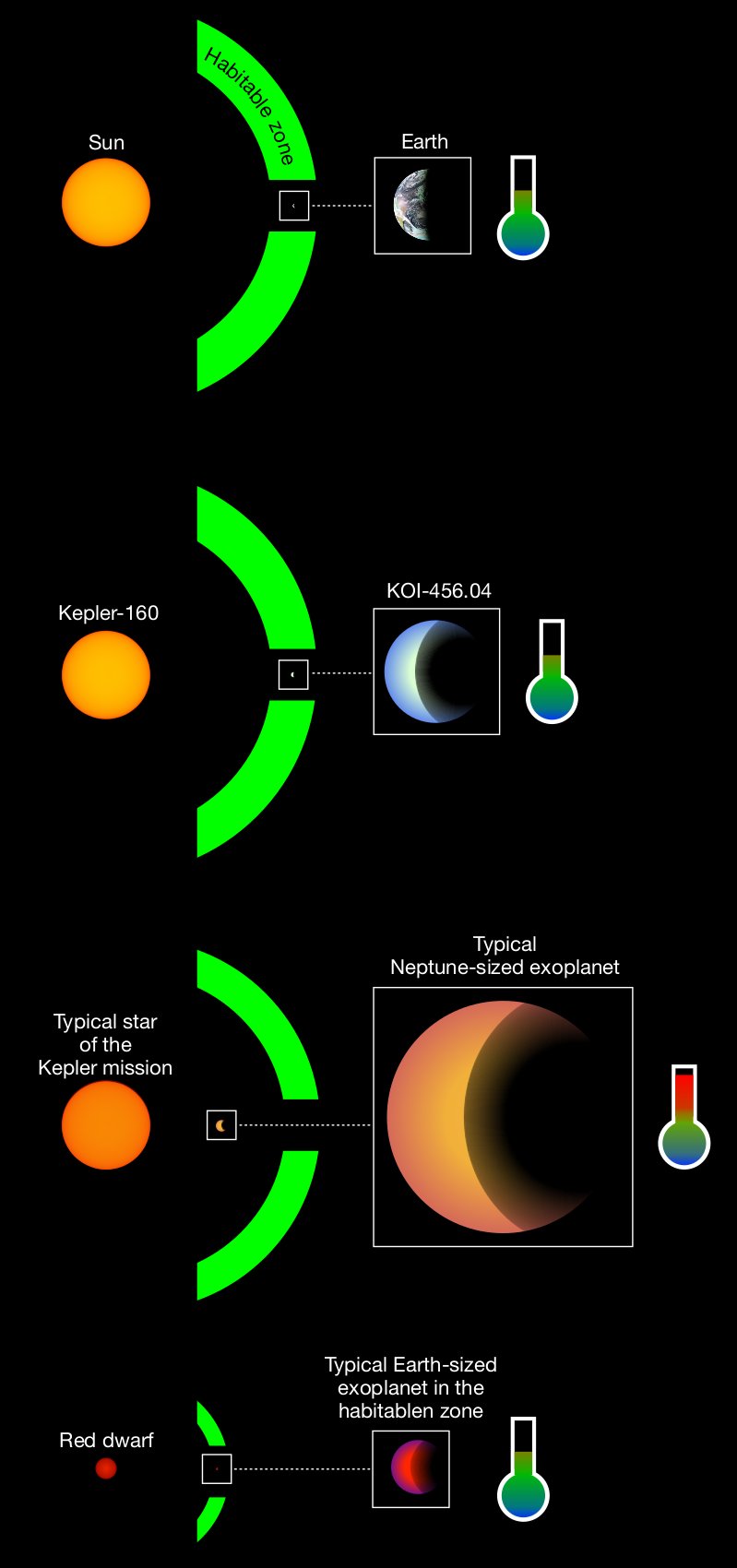Max Planck Institute for Solar System Research | 2020 Jun 04
The star Kepler-160 and its companion KOI-456.04 are more reminiscent of the Sun-Earth system than any previously known exoplanet-star pair
The star Kepler-160 is probably orbited by a planet less than twice the size of the Earth with a star-planet distance that could permit planetary surface temperatures conducive to life. The newly discovered exoplanet, which was found by a team of scientists led by the Max Planck Institute for Solar System Research (MPS) in Göttingen is more than just another potentially habitable world. One of the key properties making it resemble the Sun-Earth system more than any other previously known world, is its Sun-like host star. Most of the Earth-like exoplanets known so far are in orbit around a faint red dwarf star emitting their energy mostly as infrared radiation rather than as visible light. The light shed on KOI-456.04 by its Sun-like host star, however, is very much like the daylight seen on our home planet. Moreover, the orbital period of KOI-456.04 around its Sun-like star is almost identical to an Earth year.
- Most of the exoplanets from the Kepler mission are the size of Neptune and in relatively close orbits around their host stars, where temperatures on these planets would be far too hot for liquid surface water (third panel from above). Almost all of the Earth-sized planets known to have potentially Earth-like surface temperatures are in orbit around red dwarf stars, which do not emit visible light but infrared radiation instead (bottom panel).The Earth is in the right distance from the Sun to have surface temperatures required for the existence of liquid water. The newly discovered planet candidate KOI-456.04 and its star Kepler-160 (second panel from above) have great similarities to Earth and Sun (top). Credit: MPS / René Heller
Space telescopes such as CoRoT, Kepler, and TESS have allowed scientists the discovery of about 4000 extrasolar planets (planets around distant stars) within the past 14 years. Most of these planets are the size of the gas giant planet Neptune, about four times the size of the Earth, and in relatively close orbits around their respective host stars. But scientists have also discovered some exoplanets as small as the Earth that could potentially be rocky. And a handful of these small planets are also at the right distance to their host star to potentially have moderate surface temperatures for the presence of liquid surface water – the essential ingredient for life on Earth. “The full picture of habitability, however, involves a look at the qualities of the star too”, explains MPS scientist and lead author of the new study Dr. René Heller. So far, almost all exoplanets less than twice the size of Earth that have a potential for clement surface temperatures are in orbit around a red dwarf.
Red dwarf stars are known for their extremely long lifetimes. Life on an exoplanet in orbit around an old red dwarf star could potentially have had twice as much time than life on Earth to form and evolve. But the radiation from a red dwarf star is mostly infrared rather than visible light as we know it. Many red dwarfs are also notorious for emitting high-energy flares and for frying their planets, which would later become habitable, with enhanced stellar luminosities as long as these stars are young. Moreover, their faintness requires any habitable planet to be so close to the star that the stellar gravity starts to deform the planet substantially. The resulting tidal heating in the planet could trigger fatal global volcanism. All things combined, the habitability of planets around red dwarf stars is heavily debated in the scientific community.
In their new research article, the team of scientists ,,, now reports the discovery of a planet candidate less than twice the size of the Earth and with moderate illumination from a Sun-like star. At a distance of just over 3000 lightyears from the solar system, the star Kepler-160 was located in the field of view of the Kepler primary mission and was continuously observed from 2009 to 2013. Its radius of 1.1 solar radii, its surface temperature of 5200 degrees Celsius (300 degrees less than the Sun), and its very Sun-like stellar luminosity make it an astrophysical portrayal of our own parent star. ...
Transit Least-Squares Survey III. A 1.9 R_Earth Transit Candidate in the Habitable Zone of
Kepler-160 and a Nontransiting Planet Characterized by Transit-Timing Variations ~ René Heller et al
- Astronomy & Astrophysics 638:A10 (June 2020) DOI: 10.1051/0004-6361/201936929
- arXiv.org > astro-ph > arXiv:2006.02123 > 03 Jun 2020
